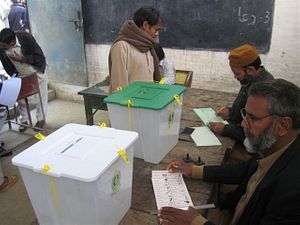The Pakistan Muslim League-Nawaz (PML-N) won a surprising victory in Punjab’s recent by-election, pointing toward rapidly changing political dynamics in Pakistan. In Monday’s by-election, the PML-N won the NA-154 National Assembly seat with a considerable margin.
The constituency was considered a stronghold of the Pakistan Tehreek-e-Insaaf (PTI). The loss of the PTI in NA-154 and the ruling party’s totally unexpected victory has created some very interesting developments in the run-up to the next general election, which is scheduled to take place later this year.
Clearly, NA-154’s result doesn’t bode well for PTI’s chances against the ruling party in Punjab in the upcoming general election. Among other things, the results of the recent by-election demonstrate that the PTI’s so-called slogan of change has not effectively convinced Punjab’s voters. Rather, Punjab’s voting tendencies appears to remain unaffected by the PTI’s active and relentless campaign to malign the PML-N in the eyes of its traditional voter base.
While the PTI may have been successful in creating a popular narrative that calls for change against the ruling party’s alleged corruption and ineffective governance, the narrative has proven to be unsuccessful when it comes to breaking entrenched local political patterns, which are still closely tied to caste, ethnicity, and family loyalties. The result of the recent by-election clearly shows that Imran Khan’s political party still lacks a viable strategy when it comes to penetrating existing local political dynamics of rural and semi-urban constituencies of Punjab. PTI’s defeat in a constituency where it had won previously by a considerable majority means that the party is vulnerable in rest of the province, where it doesn’t even have candidates that can secure victory by exploiting their caste and family ties.
In this regard, the PTI has remained focused on a failed strategy: the party’s entire campaign was geared toward exposing alleged corruption through mass media rather than working on securing winnable candidates in the province. One of the reasons that PTI’s candidate lost the recent by-election is because the constituency’s ethnic and caste dynamics saw the latter’s so-called apolitical rhetoric for “change” as contradictory to their political interests.
While Khan’s call for change sits well in broader narrative, it was ineffective when it came to the constituency’s local problems. “This was domestic politics. We often forget that a lot of opinions and arguments we make in mass media are very big city centric. Voters have local concerns; they vote for what works the best for them,” says Adnan Rasool, who closely follows Punjab’s political dynamics.
On the other hand, the ruling party’s victory in the NA-154 by-election means that the party’s political hold in the province of Punjab remains intact. Despite opposition political and religious parties’ efforts to weaken the ruling party internally, PML-N appears to be emerging as the clear winner as far as the next general election is concerned. After the recent win, the looming perception regarding potential divisions within the ranks of the ruling party has simply gone away.
With the ruling party’s win in a constituency that was among the few clear winnable seats for the PTI in Punjab, even the more opportunistic political figures who may have been considering shifting political loyalties are now going to stay with PML-N. This situation only makes the opposition political groups’ chances in Punjab further difficult: unless opposition political and religious groups make a significant break in terms of securing the ruling party’s candidate lineup, the former is not likely to challenge the latter’s growing election momentum.
Moreover, another emerging worrying trend in Punjab is the growing voter constituency of extreme right religious groups. In Punjab’s last three major by-elections, a far-right religious group, whose election campaigns have only incited violence against progressive and liberal voices in the country, has emerged as the third largest party in terms of votes.
Arguably, in the next general election, the developing contest appears to be between right and extreme right political-religious groups, with the ruling party also patronizing radical Islamist groups in the province. Such opportunist political campaigns are only going to feed into the violent narrative of far-right religious organizations.
Certainly, Khan’s party was looking to record a momentous win in the last by-election before the general election to shape its electoral agenda and build momentum in Punjab. However, the PTI’s defeat in NA-154 has placed the PML-N on a winning trajectory, with the ruling party now eyeing a majority in the parliament.
































